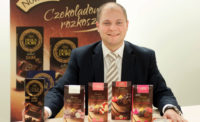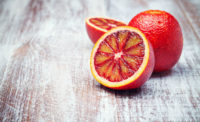What happens when you pair the bold and powerful wines of the Tuscany region — specially, the Sangiovese Grosso Brunello grape variety — with a chocolate rose — specifically a Rose of the Dolomite that features a hazelnut cream, fine roasted hazelnut pieces and dark chocolate petals?
The answer: Pure pleasure. Moreover, it’s a pairing that demands repetition.
But what’s particularly fascinating about this “natural” combination is that both products come from one family, the Loackers.
A. Loacker AG/Spa, headed up by Armin Loacker, his sister, Christine Zuenelli, and her son, Ulrich Zuenelli, produces the recently launched Rose of the Dolomite praline while Tenute Loacker, overseen by Hayo and Franz Josef Loacker, crafts Corte Pavone Brunello di Montalcino wines among its many vintages.
Well known in confectionery circles as the premium supplier of wafers and chocolate specialties throughout the world, the South Tyrolian-based A. Loacker AG/Spa has continued to expand upon its baking and confectionery heritage dating back to 1925.
In using only natural and quality ingredients to produce confections that satisfy and delight, the company has grown to become a $340-million multi-national that stays true to its motto of providing consumers nothing but “Pure goodness.”
When determining to produce a “designer praline” to include among its broad range of products, the R&D team, headed up by Armin Loacker, chose the Alpine rose as the basis for its concept.
The roses, which dot the Dolomite mountain range in South Tyrol and color the landscape with their delicate hue every evening, accent the company’s emphasis on subtle yet all-natural tastes.
Every detail, from the mould design of the rose to the fine roasted pieces of hazelnut, accentuates the sophistication behind one of Loacker’s most premium products.
That same passion extends to the Tenute Loacker winery, which was established by Rainier Loacker in 1978 with 7 hectares of vineyards near the towns of Schwarhof, Kohlerhof and Kalter Keller that surround Bolzano in South Tyrol.
Later in 1996, the company acquired wineries in Tuscany (Montalcino and in the coastal area of the Maremma). Today, Tenute Loacker vineyards encompass 45 hectares in total.
More importantly, since its founding, the company has committed to tending its vineyards strictly according to bio-dynamic [organic] and homeopathic principals.
Those principals assert that in all its vineyards the company will not resort to using synthetic or chemical methods as remedies to resolve problems. Again, similar to A. Loacker AG/Spa, Tenute Loacker embraced a philosophy embedded in purity and dedicated to a natural production process.
When the family decided to make wine in Tuscany, it chose 17 hectares in the Corte Pavone estate within Montalcino, arguably one of Italy’s most prestigious wine-growing appellations.
Tenute Loacker’s Corte Pavone estate extends across the Montalcino hillsides at approximately 500 meters of altitude, where carefully selected clones of Sangiovese grapes thrive used in the production of Brunello and Rosso di Montalcino wines.
Visitors will find aromatic plants and herbs —such as rosemary, lavender and thyme — interspersed among the vines, adding color and character to the landscape and eventually to the wines.
The Brunello di Montalcino is made from 100% Sangiovese Grasso and aged four years in barrels (a mixture of large Slovanian oak casks, mid-sized Austrian barrels and small French barriques) and an additional year in bottles.
According to the May 2012 issue of Wine Enthusiast magazine, the Corte Pavone 2007 Brunello di Montalcino “…opens with thick concentration and balsam notes of cola, hummus and eucalyptus. Despite the thick extraction, the berry aromas are delicate, with lingering wild raspberry and forest fruit. The wine shows a nice juxtaposition between its bold, masculine side and an elegant feminine one. The mouthfeel is bold, plush.” Wine Enthusaist rated the Corte Pavone 2007 at 96.
Below are comments from Franz Josef Loacker, head of Tenute Loacker and Candy Industry’s editors about the pairing.
|
A. Loacker AG/Spa’s Rose of the Dolomites
Loacker: “The fine and pleasant bittersweet taste of the Rose of the Dolomites pralines uncovers the soft tannins on the palate and even increases their elegance. The small hazelnut pieces go perfectly with the intense wild berry nuances of our 2007 Brunello di Montalcino. These are two great products that get along very well organoleptically, with cocoa and hazelnut from the Rose of the Dolomites on one side and the raspberry and full-bodied breath of our Brunello, on the other. The two together can melt away any gourmet. It’s not a coincidence that the hazelnut is a symbol of fertility, life and love ... just like this wine! — Franz Josef Loacker, Tenute Loacker
Candy Industry: The smooth hazelnut and dark chocolate flavors in the Rose of the Dolomites pralines complement the dry Brunello di Montalcino wine extremely well. The rose-shaped confection — filled with a hazelnut paste that features crunchy roasted hazelnut pieces — delivers the perfect balance of nutty center and bittersweet dark chocolate flavor. When consumed while enjoying a glass of the wine, which has raspberry tones, the result is a creamy experience that’s neither overwhelmingly sweet nor overwhelmingly bitter. Like any good pairing, the two are delicious when enjoyed alone, but when paired, they accentuate each other’s most gratifying qualities. — Crystal Lindell, associate editor, Candy Industry
Candy Industry: As the headline attests, this is a pairing of the bold and the beautiful. The 2007 Brunello di Motalcino is not for the faint-hearted; the wine rushes in with a forest of flavors, from berries to woods. However, it is the Rose of The Dolomites praline, distinctive in its own right with a creamy hazelnut center that’s embellished with roasted hazelnut pieces and enveloped in a wonderous dark chocolate, which sublimes the Brunello’s intensity. It is at this conflaguration of forest and fauna that the taster recognizes he or she is in a special place, sunlight bursting through a natural reserve of chocolate, hazelnuts, grapes and passionate craftsmanship. — Bernard Pacyniak, editor-in-chief, Candy Industry |







